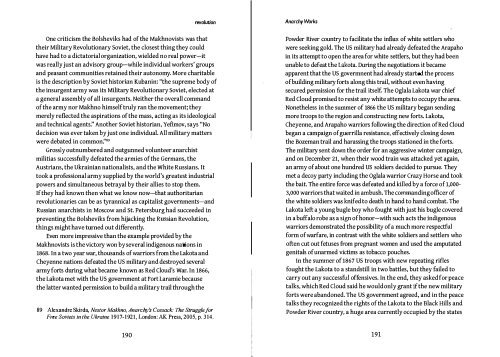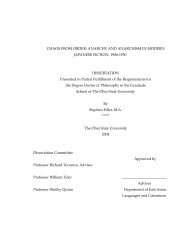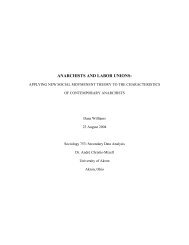Anarchy Works.pdf - Infoshop.org
Anarchy Works.pdf - Infoshop.org
Anarchy Works.pdf - Infoshop.org
Create successful ePaper yourself
Turn your PDF publications into a flip-book with our unique Google optimized e-Paper software.
evolution<br />
<strong>Anarchy</strong> <strong>Works</strong><br />
One criticism the Bolsheviks had of the Makhnovists was that<br />
their Military Revolutionary Soviet, the closest thing they could<br />
have had to a dictatorial <strong>org</strong>anization, wielded no real power-it<br />
was really just an advisory group-while individual workers' groups<br />
and peasant communities retained their autonomy. More charitable<br />
is the description by Soviet historian Kubanin: "the supreme body of<br />
the insurgent army was its Military Revolutionary Soviet, elected at<br />
a general assembly of all insurgents. Neither the overall command<br />
of the army nor Makhno himself truly ran the movement; they<br />
merely reflected the aspirations of the mass, acting as its ideolOgical<br />
and technical agents:' Another Soviet historian, Yefimov, says "No<br />
decision was ever taken by just one individuaL All military matters<br />
were debated in common:'·9<br />
Grossly outnumbered and outgunned volunteer anarchist<br />
militias successfully defeated the armies of the Germans, the<br />
Austrians, the Ukrainian nationalists, and the White Russians. It<br />
took a profeSSional army supplied by the world's greatest industrial<br />
powers and simultaneous betrayal by their allies to stop them.<br />
If they had known then what we know now-that authoritarian<br />
revolutionaries can be as tyrannical as capitalist governments-and<br />
Russian anarchists in Moscow and St. Petersburg had succeeded in<br />
preventing the Bolsheviks from hijacking the Russian Revolution,<br />
things might have turned out differently.<br />
Even more impressive than the example prOVided by the<br />
Makhnovists is the victory won by several indigenous nations in<br />
1868. In a two year war, thousands of warriors from the Lakota and<br />
Cheyenne nations defeated the us military and destroyed several<br />
army forts during what became known as Red Cloud's War. In 1866,<br />
the Lakota met with the US government at Fort Laramie because<br />
the latter wanted permission to build a military trail through the<br />
89 Alexandre Skirda, Nestor Makhno, <strong>Anarchy</strong> s Cossack: The Struggle for<br />
Free Soviets in the Ukraine 1917-1921, London: AK Press, 2005, p. 314.<br />
Powder River country to facilitate the influx of white settlers who<br />
were seeking gold. The US military had already defeated the Arapaho<br />
in its attempt to open the area for white settlers, but they had been<br />
unable to defeat the Lakota. During the negotiations it became<br />
apparent that the US govermnent had already started the process<br />
of building military forts along this trail, without even having<br />
secured permission for the trail itself. The Oglala Lakota war chief<br />
Red Cloud promised to resist any white attempts to occupy the area.<br />
Nonetheless in the summer of 1866 the us military began sending<br />
more troops to the region and constructing new forts. Lakota,<br />
Cheyenne, and Arapaho warriors following the direction of Red Cloud<br />
began a campaign of guerrilla resistance, effectively closing down<br />
the Bozeman trail and harassing the troops stationed in the forts.<br />
The military sent down the order for an aggressive winter campaign,<br />
and on December 21, when their wood train was attacked yet again,<br />
an army of about one hundred Us soldiers decided to pursue. They<br />
met a decoy party including the Oglala warrior Crazy Horse and took<br />
the bait. The entire force was defeated and killed by a force of 1,000-<br />
3,000 warriors that waited in ambush. The commanding officer of<br />
the white soldiers was knifed to death in hand to hand combat. The<br />
Lakota left a young bugle boy who fought with just his bugle covered<br />
in a buffalo robe as a sign of honor-with such acts the indigenous<br />
warriors demonstrated the possibility of a much more respectful<br />
form of warfare, in contrast with the white soldiers and settlers who<br />
often cut out fetuses from pregnant women and used the amputated<br />
genitals of unarmed victims as tobacco pouches.<br />
In the summer of 1867 US troops with new repeating rifles<br />
fought the Lakota to a standstill in two battles, but they failed to<br />
carry out any successful offensives. In the end, they asked for peace<br />
talks, which Red Cloud said he would only grant if the new military<br />
forts were abandoned. The US government agreed, and in the peace<br />
talks they recognized the rights of the Lakota to the Black Hills and<br />
Powder River country, a huge area currently occupied by the states<br />
190<br />
191
















